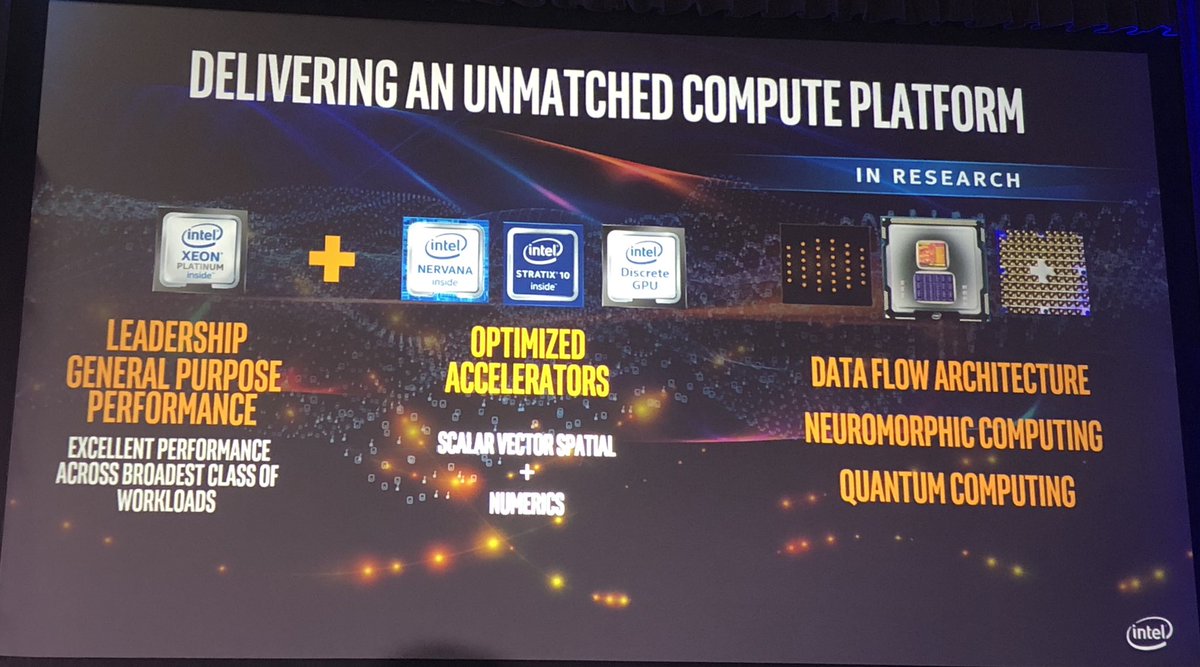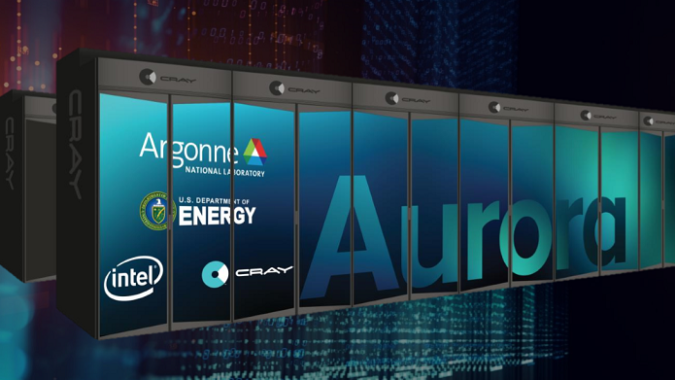The U.S. Department of Energy along with Intel and Cray confirmed today that an Intel/Cray supercomputer, “Aurora,” capable of sustained performance of one exaflops, will be delivered by the end of 2021 to Argonne National Laboratory and become the United States’ first exascale supercomputer. The retooled CORAL contract is valued at more than $500 million; Intel is still the prime and Cray is still the sub-contractor (as per the original CORAL contract, which was rewritten but not put out for rebid).
Today’s announcement left unanswered questions about Aurora, in particular details on the “novel” technologies previously alluded to by Intel and the DOE that will be incorporated in Aurora21. But Intel did put a name – Xe – to the mystery that is its next-generation architecture, which while not available in the wild yet, undergirds the DOE’s plans to achieve sustained exascale in 2021.
In summary, here’s what Intel and the DOE offered up about the Aurora design:
Aurora — a Cray “Shasta” system — will be based on a future generation of Intel Xeon Scalable processor, Intel’s Xe compute architecture, a future generation of Intel Optane Datacenter Persistent Memory, and Intel’s One API software. Those technologies will be embodied in more than 200 Shasta cabinets, all connected by Cray’s Slingshot interconnect and the Shasta software stack.
“Aurora will use a combination of Intel software components and new Cray System software designed for Shasta to enable modularity and extensibility of the system over time,” said Cray. “By unifying the Shasta compute and Slingshot interconnect with a single management and software application development infrastructure, workloads on the Aurora system will run more optimally to deliver researchers more realized performance and accelerate their time to insight.”
Cray’s contract is valued at more than $100 million, one of the largest in Cray’s history. Aurora is the second major win for Shasta systems in the last six months. Cray’s contract with NERSC, for the Shasta system known as “Perlmutter” is worth $146 million.
During a pre-briefing held for media last Friday (March 15), Intel provided no technical details on the new Xe architecture — on whether it would incorporate the new discrete GPU that Intel slyly showed on a foil at SC18 in Denver, for example.

What Intel’s Rajeeb Hazra did say was that “Xe represents a tremendous amount of R&D and innovation to extend what is done in the franchise to address new workload needs, particularly the kinds of workloads we see coming in the convergence of HPC, AI and data analytics.”
The partners — the DOE, Argonne Lab, Intel and Cray — are unified in emphasizing not just the significance of crossing the exascale horizon, but Aurora’s role in accelerating the convergence of high performance computing and traditional modeling and simulation with data analytics and AI.
“This system will be an excellent platform for both traditional high performance computing applications but also is being designed to be excellent for data analytics, particularly the kinds of streaming data problems we have in the DOE, where we have data coming off accelerators, detectors, telescopes and so forth,” said Rick Stevens, associate laboratory director for computing, environment and life sciences at Argonne, during Friday’s briefing.
Stevens also said Aurora will be “exclusively configured” to be an excellent platform for deep learning.
“This platform is designed to tackle the largest AI training and inference problems that we know about,” he stated. “There are over a hundred AI applications being developed by the various national laboratories. As part of the Exascale Computing Project, there’s a new effort around exascale machine learning, and that activity is feeding into the requirements for Aurora, particularly the software environment; the hardware will be very excellent for training and will achieve state of the art performance on training.”
In speaking generally about the requirements for Aurora, Hazra — Intel’s corporate vice president and general manager of enterprise and government group — mentioned the importance of: “new process technologies, designing efficient silicon, and most importantly…new ways to put together silicon with packaging innovations.”
It’s all part of the “six pillars of innovation” that Intel has been focusing on in recent customer and partner (and media) engagements.
Argonne’s Stevens believes the convergence of machine learning, deep learning and simulation will create a multiplier effect for the progress of scientific discovery. “We see many groups that are doing simulations – wanting to incorporate various machine learning or AI methods directly into those simulations or to control or manage large numbers of simulations with AI to do active learning approaches, so in general we think this will create another wave of acceleration across many areas of science, technology and health care,” he said.
Stevens is personally looking forward to how the increase in compute and new data analytics capabilities will boost Argonne’s efforts with the National Institutes of Health and Cancer, as well as with the Veteran’s Administration, which in collaboration with the DOE, is applying large-scale data analytics and machine learning to understanding the risk factors for suicide and strategies for improving outcomes in suicide. Better understanding cardiac risk and traumatic brain injuries are further application areas. Aurora will be available to the DOE complex, as well as the U.S. university system through programs like INCITE as well as being available to the American industry, Stevens reported.
Areas the Exascale Computing Project (ECP) has been investing in include material science, e.g., designing better battery materials, more efficient photovoltaics, and advanced materials for wind power or nuclear reactors. Other ECP projects are evaluating earthquake hazard risk; another is looking to apply simulation and AI to additive manufacturing. There are projects focused on improving wind turbine efficiency, and others advancing climate and weather forecasting.
National security and defense applications are of course critical to DOE leadership supercomputing. DOE Under Secretary for Science Paul Dabbar on Friday referenced the importance of HPC for managing stockpile stewardship. “A lot of our defense applications at the department are utilizing high performance computing since the test treaty was signed and this capability allows us to continue and accelerate our understanding of those needs,” he said.
In 2018, the DOE national lab complex commissioned the number one and number two supercomputers in the world — Summit and Sierra at Oak Ridge and Livermore Lab respectively — and it houses five of the world’s top ten supercomputers (as ranked by the Top500 and High Performance Linpack benchmark).
Commenting on the challenge of closing the delta between Summit (~150 petaflops) and Aurora (>1,000 petaflops) in three years, Stevens said: “Exascale R&D has been going on for over a decade and the innovation curves on which these exascale platforms are being based are moving extremely rapidly, so yes, this machine will arrive only about three years after the current number one machine has been on the floor, but during that time there will be some quickened advances in both architecture and software needed to achieve this performance goal.”
Funding for Aurora is included in Trump’s 2020 budget request that came out last Monday (March 11): “$500 million for the DOE Office of Science as well as $309 million for the National Nuclear Security Administration … [will] enable the deployment of an Exascale computer system in calendar year 2021.”
Comments shared by partners:
“Achieving exascale is imperative, not only to better the scientific community, but also to better the lives of everyday Americans,” said U.S. Secretary of Energy Rick Perry. “Aurora and the next generation of exascale supercomputers will apply HPC and AI technologies to areas such as cancer research, climate modeling, and veterans’ health treatments. The innovative advancements that will be made with exascale will have an incredibly significant impact on our society.”
“Today is an important day not only for the team of technologists and scientists who have come together to build our first exascale computer – but also for all of us who are committed to American innovation and manufacturing,” said Bob Swan, Intel CEO. “The convergence of AI and high-performance computing is an enormous opportunity to address some of the world’s biggest challenges and an important catalyst for economic opportunity.”
“There is tremendous scientific benefit to our nation that comes from collaborations like this one with the Department of Energy, Argonne National Laboratory, and industry partners Intel and Cray,” said Argonne National Laboratory Director, Paul Kearns. “Argonne’s Aurora system is built for next-generation Artificial Intelligence and will accelerate scientific discovery by combining high-performance computing and artificial intelligence to address real world problems, such as improving extreme weather forecasting, accelerating medical treatments, mapping the human brain, developing new materials, and further understanding the universe – and that is just the beginning.”
“Cray is proud to be partnering with Intel and Argonne to accelerate the pace of discovery and innovation across a broad range of disciplines,” said Peter Ungaro, president and CEO of Cray. “We are excited that Shasta will be the foundation for the upcoming exascale-era characterized by extreme performance capability, new data-centric workloads, and heterogeneous computing.”
“It seems fitting that America’s first exascale supercomputer, the country’s initial entrant in the global exascale race, is a Cray, a name synonymous with the word supercomputer,” said Steve Conway, Hyperion Research senior vice president of research. “This implementation of Cray’s Shasta architecture was developed in collaboration with Intel and closely matches the wish list that leading HPC users have for the exascale era, but didn’t expect to see so soon.”





























































